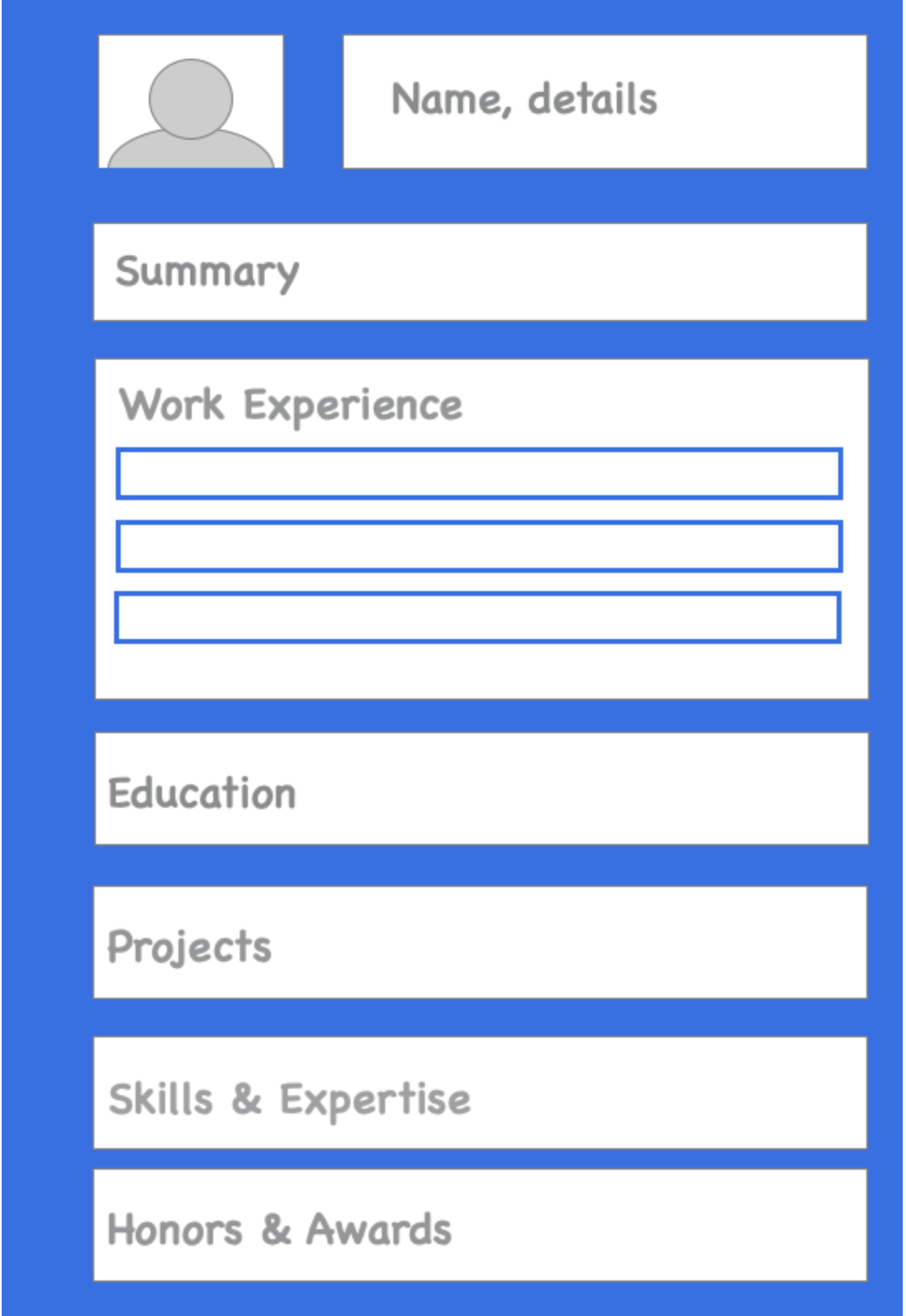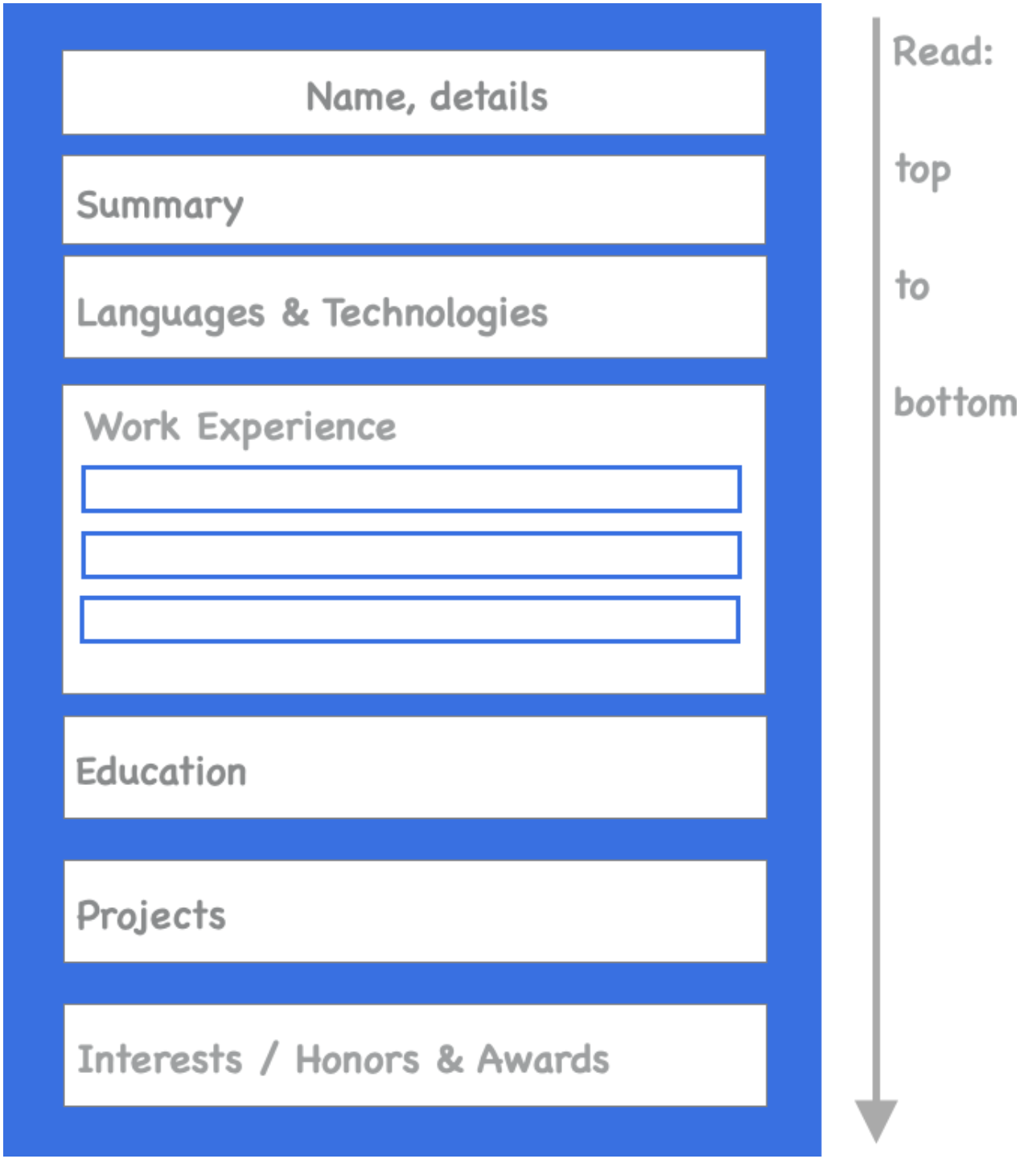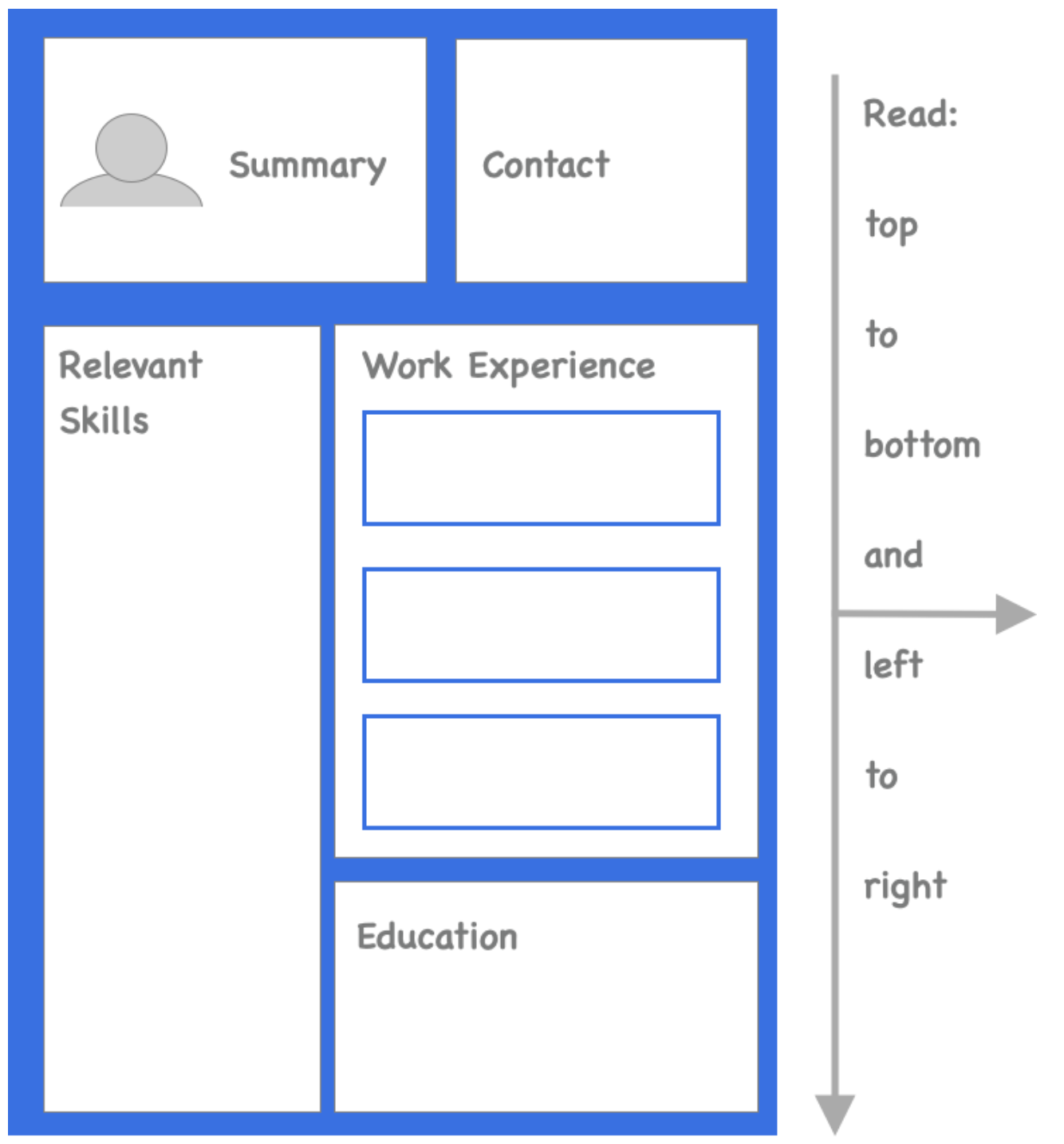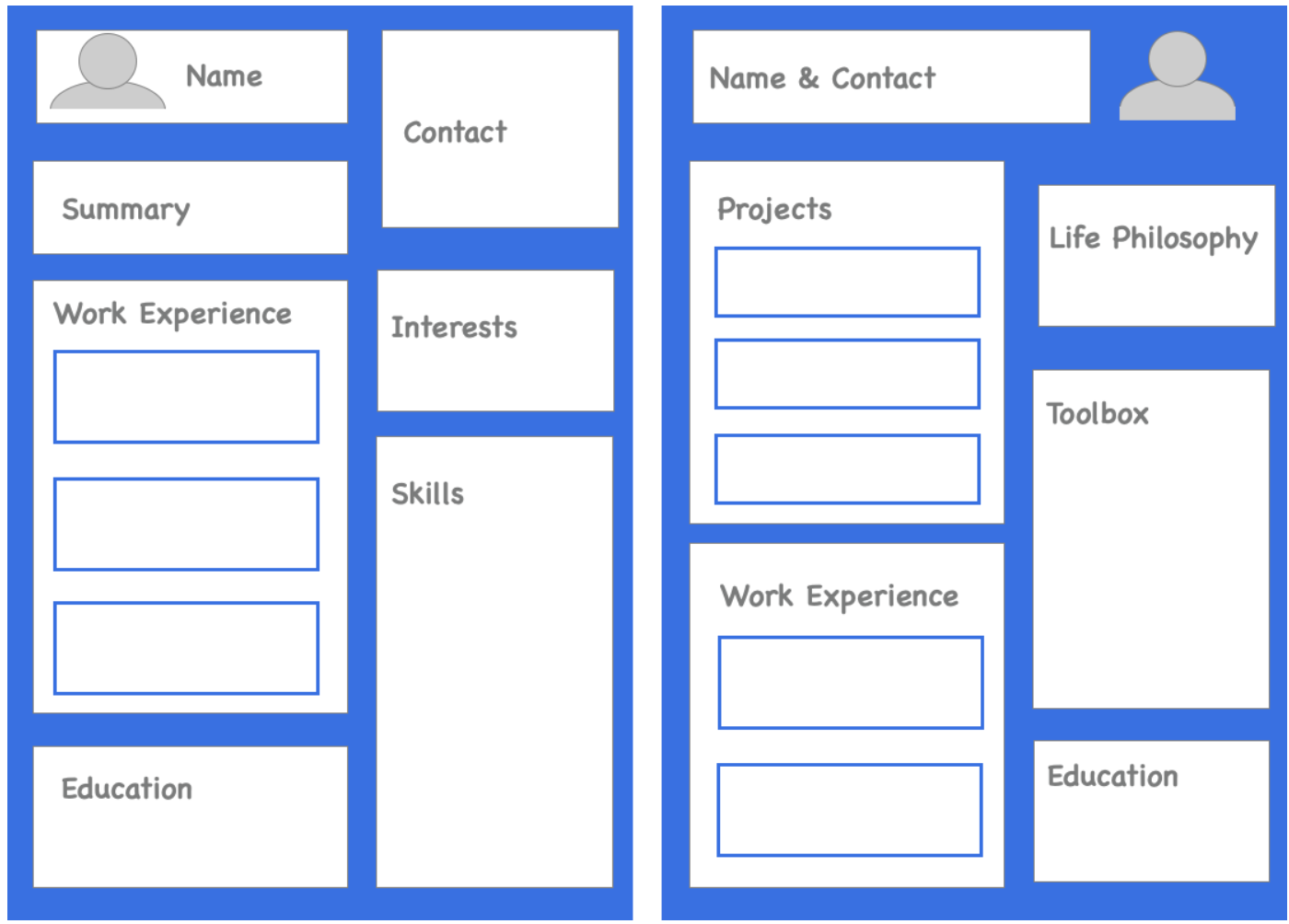The below sections are part of Chapter 11: Good Resume Template Principles in The Tech Resume Inside Out book.
Before choosing a resume template, it’s important to understand what principles make for a good template. A good template is one that will help with the goal that you had writing a resume: conveying the information that you intended to communicate in a way that the recruiter or hiring manager can quickly understand.
In a world where a recruiter receives one application to review per day, resume templates wouldn’t matter. In fact, most of this guide would be of little use. The recruiter would take their time, read the whole resume, and probably still give you a call to find out if there is any way you’d be qualified for the position. I mean, you are one of the very few applicants!
However, in reality, recruiters and hiring managers often have dozens or hundreds of resumes to go through. They become really efficient at doing so. If a resume proves to be too much work to find key pieces of information, then it’s down to luck if they will take this time, or just move to the next one.
Good resume templates are made tailored for recruiters and hiring managers—not for job seekers. It makes the job of these recruiters and hiring managers in finding key pieces of information as effortless as possible.
A good resume template is easy to read. They are easy to read because they follow common conventions that people are used to. Things that people are used to when reading nonfiction are these:
Every hiring manager, and tech recruiter I’ve talked with read resumes top to bottom. This includes myself. It’s not just a habit: it’s also a recommendation. One of the most hands-on hiring manager guide in tech is the book Hiring Geeks that Fit. Here author Johanna Rothman suggests the same:
Start reading each resume at the top. I read résumés by starting at the top, and work my way down to the final line. (...) Seeing what a candidate thinks are his or her strong points can tell you a lot about the candidate. (...) As I read, I make a mental note that I later will compare with the actual job’s requirements in each of the following areas: work experience, position objective, strengths, education, and professional training. I use items in the résumé to include candidates, and only use items to exclude candidates if the items match my elimination criteria.
Let’s look at the two most popular layouts, and how they help with these principles.
The format that all recruiters in tech will be vastly familiar with is the LinkedIn profile format. They read profiles like this day in, day out. Here’s what the LinkedIn profile layout looks like when recruiters view candidates:

Resume templates that follow this format in their layout are a safe bet. Do keep in mind that LinkedIn follows a generic format for resumes. For software developers, languages & technologies are especially important. This is something that LinkedIn won’t place emphasis on, but you should, in your resume. An adjusted format that works better for developers, yet be familiar in layout for recruiters is this one:

Top-down layouts work well for multi-page resumes as well. The only possible downside of this format is that it seemingly does not maximize the space on a page as efficiently as a multi-column layout. Still, given how familiar and easy to read this format is, there is little reason not to use it for your resume.
Another popular layout is a two-column one. The goal of this layout is to maximize space for one-page resumes. Here’s how a layout could look:

While this template seemingly does maximize space, it does this at the expense of readability. The reader needs to read top to bottom, then start again, going left to right. Also, in this format, it becomes confusing for recruiters to know where to look for key information like education or work experience. Ten resumes with two-column layouts will have their columns in ten different orders. Take a look at these two two-column resume examples, both popular layouts:

The columns are in a different order, even compared to the first example. This makes it harder for recruiters to find the key pieces of information that they are looking for—and that is so easy to spot in the top-to-down resume format.
The biggest drawback of the two-column resume is how it discourages sharing sufficient details on your experience, both for work experience and for projects. None of the two-column designs cater for sharing several bullet points per position. None of the two-column layouts incentivize going beyond one page for your resume. This resume format is more likely to be filled with buzzwords and cliches than to describe the impact of your work with the technologies you use.
Two-column layouts can be a great choice in cases where your resume layout is part of the application, such as for design or UX positions. In industries outside of software engineering, they might also work. However, for software developers, there is no advantage to using this layout—you’ll only experience drawbacks if choosing this format.
Chukwuemeka Ugorji is a technical recruiter who has worked at Facebook and Andela. He has seen thousands of resumes with various formats and gives his take on the benefits and drawbacks of the top-down and two-column resumes:
I consider a resume a brief story of your career or maybe a 10 seconds ‘elevator pitch’. If you can tell the story right in 10 seconds, then you get the time to discuss more.
I consider the top-down format I the most optimal for two reasons. First, it is the most organized format for easy readability. Second, it allows for easy flow of thought. It starts with what a recruiter/hiring manager is most curious about: skills & relevant experience. Hence, this format immediately answers the key questions that the hiring team has for any candidate.
The two-column layout is a double-edged sword. You need to be brief with this format. If you succeed to show that you are relevant based on your skills and work experience, you will be an easy pick candidate to advance. If not, the decision to reject will be an immediate one.
This format is like an infographic. It saves the time of the recruiter or hiring manager. However, it can hurt candidates badly if they aren't great at presenting relevant information succinctly
Get The Tech Resume Inside Out and carry on reading this chapter, with the sections:
Congrats to @GergelyOrosz on getting this book out there. I have read many good and not so good resumes over my career, so this advice will be useful. Also on offer for free for those looking for a job, helpful in these times 👏 https://t.co/SqnyRLwoOl
— Pat Kua (@patkua) October 9, 2020











